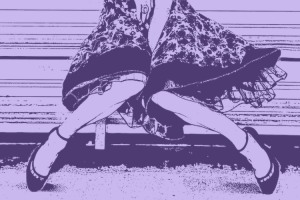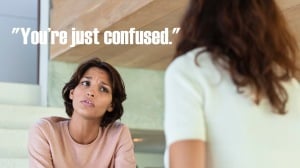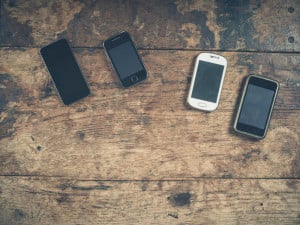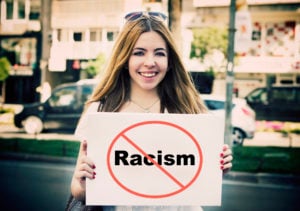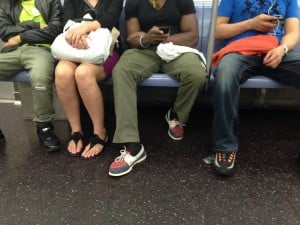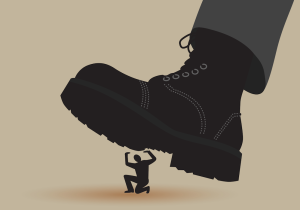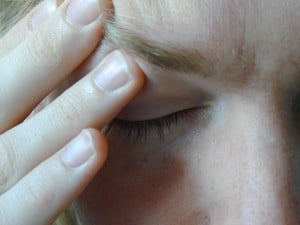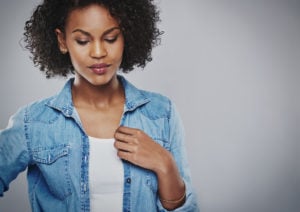
A person appearing thoughtful as they stand, looking down, tugging at their denim coat with one hand.
I’ll be forthright: As a thin woman involved in body acceptance activism, I’ve had my moments when I’ve wished that conversations made more room for me and my experiences.
Body acceptance as a movement floated into my life when I discovered feminism during the beginning of my eating disorder recovery. And I wanted so desperately to catch it like a butterfly and make it mine. I needed it. I realized, in fact, that we all needed it. And I threw myself into it with ignorant fervor, desperate to lavish in it and spread its gospel.
But in my joyous discovery of what would become a lifesaver for me, what I initially wanted from the movement was a centering on what felt relevant to my own struggles.
Particularly as a woman who is a size eight – considered plus-size by modeling standards – and isn’t the socially idealized “model thin,” I fleetingly felt like body positivity, as a movement, wasn’t really made for me.
Why can’t we have more conversations about women who aren’t fat, but who aren’t svelte either? I wondered. Where do we fit into this landscape?
Because what I was seeing on the surface in these spaces was the celebration of, still, bodies that didn’t look like mine. And when I looked to society as a whole and felt like I had to drop three sizes to be celebrated, and then looked to body-positive spaces and felt like I needed to add at least three sizes to be noticed, I felt invisible. And in my naïveté, I felt like that was inherently body-negative.
If “all bodies are good bodies,” I thought, where’s the focus on mine?
I’ve learned a lot more about the nuances of oppression since those starting days. And I’ve learned that as a movement created by fat women for fat women, it really isn’t a place for me to expect to see my experiences centered, even if I still can participate in and benefit from that.
But I still see this sentiment floating all around me: women of standard sizing wondering aloud why body acceptance feels hostile to them, trying to apply their understanding of oppression to prove “reverse discrimination,” frustrated that their attempt to center themselves and their bodies is met with derision instead of celebration.
Sometimes, still, I feel this emotion bubbling up in myself.
But the reality is that the body acceptance movement wasn’t created for us, fellow thin people. It wasn’t a place that was meant for us in the first place. And as frustrating as that can feel, it’s important for us to recognize that it doesn’t have to be centered on thin people in order to be useful – even to us.
So I asked two of my good friends (and favorite fat activists), Cathy Bouris and Kaitlyn M. Forristal, to join me in exploring this very question that gets asked so repeatedly: Does body-positivity really even care about thin people?
And here is what we came up with: four reasons why pushing for body acceptance movements to cater to thin people is not only senseless, but also hurtful.
1. Mainstream Body Positivity Already Does Include Thin Bodies
Thin people, your bodies are already represented.
Think about the popular body positive campaigns you’ve seen in the past year: Lane Bryant’s #PlusIsEqual and #ImNoAngel, or Amazon’s “I Wish I Could Wear” campaign. Or maybe even American Eagle’s male body positivity campaign that turned out to be a joke (because chubby guys liking themselves is funny – or something).
All of these campaigns include thin or average sized bodies. In many cases, it’s fat bodies that are the ones being underrepresented in these campaigns that are meant to celebrate body diversity.
Instead, the people who most need body acceptance see themselves represented by tall, curvy models with flat stomachs who wouldn’t be caught dead actually shopping in a store specifically targeted at plus-sized women.
These are models who have “curves in all the right places” – not unsightly stomach rolls or arm flab. Models like Ashley Graham, Stefania Ferrario (the driving force behind #DropThePlus), and Robyn Lawley don’t actually depict the reality of what most plus-sized women look like – and yet they’re who are being used to represent them.
In fact, ASOS recently slipped up and admitted on Twitter that their Curve models were usually a UK size 16 – which is a US size 12. Even the models used to sell plus-size clothing are barely plus-sized. On top of that, one of the worst kept industry secrets is that many of these models actually use padding to fit into larger clothes.
Most of the bodies that are featured, especially in media, as being body positive still fit into standard (or just barely plus-size) sizing. I mean, how often have you seen images of Marilyn Monroe used to make a point about body love? Her measurements were 36-24-34, making her similar in size to modern day starlets who are celebrated for their “unconventional” Hollywood bodies, like Jennifer Lawrence and Demi Lovato.
And all of those women are smaller than the average American woman.
Which begs the question: Where are thin women feeling left out of, exactly?
Thin people have noted feeling hostility toward thin bodies in fat acceptance spaces. But conversations about how you hold privilege and how that affects others isn’t hostility toward individuals; it’s anger at an oppressive system. And the truth is that thin people contribute to that system when they demand inclusion.
Marginalized people are entitled to spaces where they can discuss that experience without catering to hurt feelings. This is especially true when you consider that mainstream body positivity was born of fat feminist theory being repackaged and sold to the masses.
Being unable to participate in some conversations doesn’t equal not being included in a movement.
Also, very thin people feel that their “too skinny” social status is rarely addressed in body positivity. But there is a time and a place to have those conversations (namely, with others who share your experience).
Being asked not to make this argument during a conversation about fat experiences isn’t a sign that body acceptance isn’t “intersectional” or “inclusive” enough; it’s a hint that you might be derailing a conversation.
It’s okay to have that conversation. It’s not okay to force others to have it when they’re talking about a more marginalized experience.
Thin people aren’t being left out of this movement at all – they’re starring in it. And so they’re upset every time the conversation isn’t about them. And that’s not the same thing.
2. There Are Harder Conversations to Have About Which Bodies Really Are Excluded
Meanwhile, there are bodies that are being left out of the movement.
And when folks push for more conversations around thinness (and generally, a very specific type of thinness at that – that of white, middle class, feminine, cisgender women) to happen, they’re further silencing the harder conversations we need to be having as a movement.
Because if your feminism isn’t intersectional, then who the hell is it for?
And the mainstream body acceptance movement has a long, long way to go to be inclusive of multiple marginalized bodies.
Body acceptance activists are frequently criticized (and rightly so) for excluding non-binary or agender experiences. Any time that we talk about how “men and women” experience body image issues, or when we talk about body image issues being indicative of binary gender expectations, we leave out entire groups of people.
The intersection of body image and transgender experiences is also incredibly nuanced – and decidedly different from how cisgender people feel in their bodies. With the potentially added experience of body dysphoria thrown into the mix, as well as the pressure to “pass” and how weight and body composition can play a role in that, we need to be talking about it. Instead, many of the most popular “body-posi” mantras leave trans experiences out entirely.
Mainstream feminism, on a whole, isn’t the best at remembering to talk about dis/ability. And mainstream body acceptance movements are no exception. The Body Is Not an Apology does a kick-ass job of discussing how body politics affect dis/ability.
And viral TEDxTalks about beauty by disabled activists like Lizzie Velasquez, Shelley Baer, Aimee Mullins, and Maysoon Zayid have made the rounds again and again. But we still actively participate in an ableist “Love Your Body For What It Can Do/Healthy Is the New Skinny” culture that marginalizes people.
If you ask Google what it means to be a beautiful woman, the answer you get is overwhelmingly—well—white. And although we get a bit more diversified when we ask Google what a body-positive woman looks like, it’s by a small margin.
Whiteness, it seems, is a prerequisite for beauty, both inside and outside of mainstream body acceptance circles. And when media outlets practice whitewashing, women of color are referred to as “exotic,” and Black women are screamed at for celebrating their own beauty, we clearly have some work to do in including people of color in our conversations.
And fat people – not curvy or small-fat people, but fat people – continue to be left out of this conversation that they started. The way that body positivity has been commercialized, it doesn’t even include fat bodies.
Tess Holliday is one of the few, if not the only, plus-sized models who people can name who is considered fat, rather than curvy with the assistance of padding – and she’s notably absent from the larger body positive campaigns.
The commodification of body acceptance – advertising profiting off of the insecurities that they sold us by now selling self-love as the antidote – is a problem overall.
But it’s especially problematic when advertisers water down fat acceptance to make it more palpable to mainstream audiences – and then leave fat people out of its realm altogether, as Zaynab Shahar brilliantly breaks down in this thread.
So, are bodies being left out of body acceptance conversations on the regular? They sure are. But they sure aren’t thin ones. And if you really care about inclusion in body acceptance, these examples (and more) should be where your attention is.
3. Thin People Benefit From the Eradication of Fatphobia
There’s a reason why a lot of racial justice work focuses specifically on anti-Black racism. And there’s a reason why feminist spaces need to focus on trans women.
It’s because centering the most marginalized people of any group will benefit the group as a whole in movements for justice. When we throw our effort into supporting the folks who are most hurt by any given system, it shifts the status quo for all of us.
All people of color (and white people!) benefit from eradicating anti-Blackness. All women (and all genders!) benefit from tearing down transmisogyny. And all people benefit when we tell fatphobia to go fuck itself.
The truth is that some people are more hurt by any particular system than others are, due to the power structures that uphold that system. And in the case of fatphobic oppression, the power structure upholding it is the thin ideal.
All people are screwed by that – just like all people are hurt by any power structure. You, yourself, reading this, can probably attest to the myriad ways that the thin ideal and widespread fear and hatred of fat bodies has damaged thin people’s lives. Because it has.
The question is: Are thin people more or less hurt by that than a fat person? And why does that matter?
Stick with us through this awkward metaphor:
Let’s think of solving oppression as developing pain medication. Let’s say that, as a thin person in a fatphobic society, on a scale from one to ten, you experience three pain points. If we only ever develop a pain medication that helps up to three pain points, you’re saved! But what about everyone else?
Contrarily, if we develop a pain medication that will relieve up to all ten pain points, then everyone benefits – including you!
So does it make more sense to focus our efforts on the people with three pain points, or the ones with ten? Does it make more sense to focus the body acceptance movement on thin people, who only experience the pain of fatphobic oppression to a degree, or on fat people, who receive the brunt of the oppression?
Thin people wonder how body acceptance can be useful to them if it’s heavily focused on fat people. The difference is that when body acceptance focuses on fat people, thin people benefit. When it’s centered on thin people, fat people get left behind.
4. We Can’t Validate Thinness As Social Capital (Yes, It’s Oppressive)
At the end of the day, when thin people say “More conversations about us, please,” they’re reasserting that their bodies are deserving of more attention.
They’re asking a group of marginalized people who have put a lot of work into a movement to focus on them more because they want to benefit from it, too. And that, in and of itself, is oppressive.
You can recite versions of mantras that were created by and for marginalized people all day long, demanding that more attention be paid to you if body acceptance really believes in self-love for all.
But it’s just another hurtful version of “What about the men?”
In the same way that feminism is for everyone, including men, body positivity is for everyone, including thin people. But when thin people center themselves – making their bodies the loudest and most important in the room – they’re using their social capital of thinness to reify oppression.
You’re co-opting a movement that was created by and for fat individuals. And when you do this, you take resources away from marginalized people and assert yourselves as the most powerful.
By demanding inclusion from a movement for marginalized people when you’re a member of the privileged group, you’re asserting your social power over the marginalized.
As a thin person, your privilege allows your voice to be heard much, much louder than the multitude of fat people that came before you. And when you use the platform that you’ve been allotted to speak solely for the hurt feelings of thin people, you ignore the experiences of fat people – and you concretize the oppression they face.
And that’s not a movement to be proud of.
So the next time you find yourself wondering why you feel left out of body acceptance, ask yourself why you need it in the first place. More than likely, it’s because you, like the rest of us, were taught to hate the way you look and to be fearful of having or actually being fat.
Body positivity and body acceptance are absolutely crucial to social justice activism and our work towards a more inclusive society. However, it is the rampant and systemic loathing of fat bodies that necessitate these as vital and radical concepts.
So if it’s fat that we hate so much as a society, then it’s fat bodies that need the most attention in movements working to fix that.
And that’s why it can’t focus on you.
[do_widget id=’text-101′]
Melissa A. Fabello, Co-Managing Editor of Everyday Feminism, is a body acceptance activist and sexuality scholar living in Philadelphia. She enjoys rainy days, tattoos, yin yoga, and Jurassic Park. She holds a B.S. in English Education from Boston University and an M.Ed. in Human Sexuality from Widener University. She is currently working on her PhD. She can be reached on Twitter @fyeahmfabello.
Cathy Bouris is a 22-year-old postgrad media student from Sydney, Australia. She spends the majority of her time tweeting @catherinebouris and watching as many TV shows as is humanly possible.
Kaitlyn M. Forristal is a professional counselor, fat activist, and hardcore cat lady living in Ohio. She enjoys punk rock and smashing the white supremacist cisheteropatriarchy. She holds a BA and MA from the University of Toledo, where she is currently working on her PhD in Counselor Education and Supervision. You can find Kate on Twitter @k80mylady.
Search our 3000+ articles!
Read our articles about:
Our online racial justice training
Used by hundreds of universities, non-profits, and businesses.
Click to learn more





